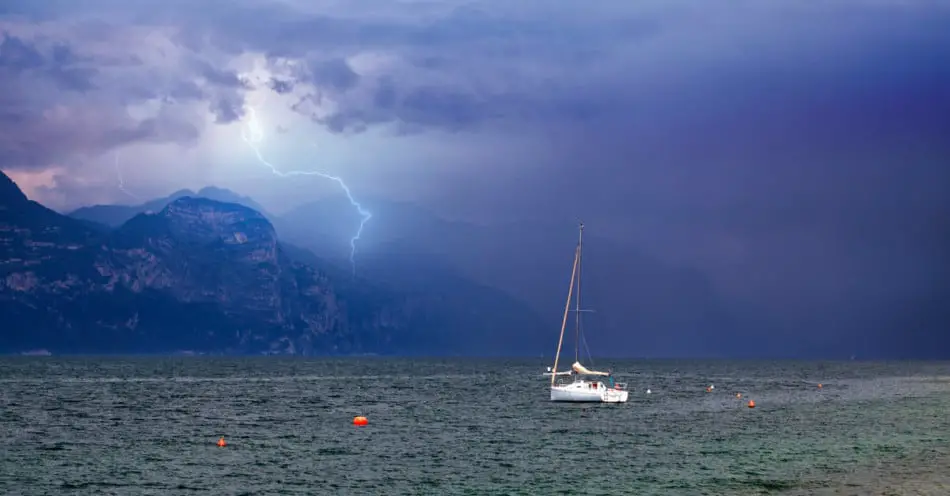If you’re out in a boat, whether it be in open water or on a lake or other inland body of water, a lightning storm can be one of a sailor’s worst nightmares. Not only can the wind pick up quickly, the currents change, and waves get large, but there is the danger of getting struck by lightning. But do you really know what would happen after that, or how safe you really are in a boat with lightning around?
Though it depends on what type of boat you’re in, being out on the water during a lightning storm is generally not regarded as safe. Lightning hits the tallest point of least resistance, and in a large body of water, that is likely to be metal or another conductor on some point of the boat.
What you should do if you’re already out on the water and not close to land, and what would happen if you did get hit by a lightning strike, as well as the chances of this happening, are all questions we’ll look into.
Is It Safe To Be In A Boat During A Lightning Storm?
No, it is not! The combination of water, which conducts electricity, lightning storms, and metal, is not a safe one, especially when there are people involved in that too, and no boat is immune, no matter how small. Having said this, lightning will affect different types of boats in different ways.
Small boats with less conducting materials on board are more at risk of lightning damage, as there are fewer places for the charge to go. This usually makes them more dangerous for passengers during a lightning storm too. Larger boats have more metal objects being conductors on board, so they may be more likely to attract lightning in the first place, but the damage will probably be less extensive.
If there is a single boat in a large body of water, it is likely to attract lightning. Loss of human life is the worst possible outcome, in addition to vessel damage, and both are entirely possible in a lightning storm. When lightning strikes, one spark can measure an area of five miles in length, delivering extremely hot temperatures and 100 million volts of electricity.
While lightning doesn’t strike water as much as land, when it does, it spreads out over the water, which acts as a conductor any boaters in its way xan be at risk of lightning injuries. If there is no land nearby and the spark hits the boat first, the charge can travel all over the boat looking for land before leaving it for the water again.
What Do You Do In A Boat During A Lightning Storm?

If a storm is approaching and there is thunder and lightning in the distance, the best course of action is to get off the water. Depending on how far from the shore the boat is, this is not always a viable option.
If you are caught in a thunderstorm, there are several actions you can take:
- Head for the cabins, and seek shelter there.
- Close the windows to prevent the boat from taking on excess water.
- Have everyone on the boat put on life jackets.
- If the boat doesn’t have a cabin, remaining as low as possible in the center of the boat is advisable.
- Stay away from any metal, including fishing rods, which should be stowed away along with anything else that could act as an attractive conductor.
- Lower antennas and turn off electronics.
Learning to read weather conditions is vital, as lightning can strike up to a mile in front of a thunderstorm cloud. If you are docked or in a slip, this does not mean you are safe from lightning strikes, even if there are larger boats around you. It is still advisable to leave the boat and seek shelter off the water. Electrical storms are no joke in the boating indusrty, so always be aware and take caution when storm clouds approach.
It is important to have a weather radio on board to be able to listen to the forecast if you see storm clouds approaching. This radio can also be used to communicate with shore in case of an accident.
Another important tool is a lighting strike detector, this will let you know you need to get off the water ASAP!
Certain boats are more likely to attract lightning in the first place. These include sail boats with a tall mast, larger boats, where the surface area presents a larger target for the sky, boats with two hulls, and boats with masts rather than powerboats.
How Can You Protect A Boat From Lightning?
While there is no way to entirely lightning-proof a boat, some boats have a lightning protection system which is a process called bonding that can help. Bonding is when all of the underwater metal fittings on a boat are electrically joined, which then helps to direct the lightning current away from passengers and major components and minimize damage.
Lightning takes the easiest path to the ground, and there is no telling through what it will go to get there, which could include humans. On the water, this path is the surface of the water, so by channeling the strike through the main conductor to an underwater plate or strip, there is an attempt to control the direction in which the electricity flows.
On sailboats, the protective system should also include cables around the masts, antennas, and other exposed conductors, which are wired to the grounding strips under the water.
Can Lightning Go Through Water?
Lightning doesn’t travel through water, per se. Before lightning strikes a body of water, an electrical charge builds up along the surface of the body, such as a lake. Once the lightning strikes, most of the electrical discharge happens near the surface of the water, so fish and other things deeper than surface level are not affected.
Scientists don’t really know how deep the lightning charge does go, though. Swimming or being on a boat or on another object on the surface of the water, such as a SUP board, where you are in contact with the surface, is therefore dangerous during a lightning storm, as you are exposed to this charge.
Conclusion
A human has about a one in a million chance of being struck by lightning. As a boat-owning human, this chance increases to about one in a thousand. Boats provide a point for the lightning to strike in water as it looks for land. Boating during a lightning storm is considered an unsafe activity, so check the weather reports and enjoy being out on the water without stress!

